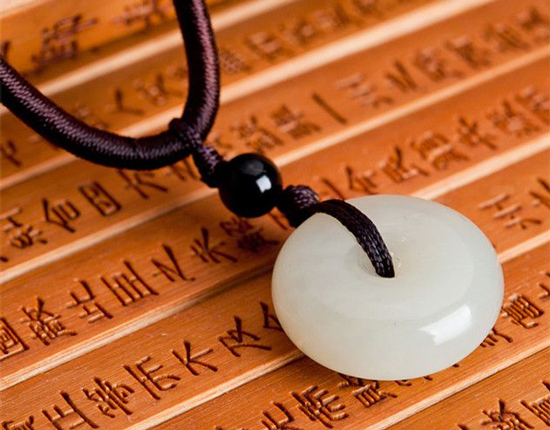Xinjiang Hetian jade has always been famous, especially to enrich the light, giving people a feeling of being soft. In the ancient days of Hetian, it was called "Yu Yu". In Chinese Tibetan, it means "the place where jade is produced". The field is located at the southernmost tip of Xinjiang, the south is Kunlun Mountain, and the north is deep into the vast Taklimakan Desert. Kunlun Mountain is the most mysterious place in China's famous mountains. The Kunlun Mountain is the source of Hetian jade.
"Thousands of agates are all kinds of jade", there are many kinds of jade. Under the polishing of nature's magical hand, the delicate texture, beautiful color, soft luster of minerals and rocks, has been endowed with the reputation of "jade", and because of the scarcity, there are many meanings of beauty, auspiciousness and holiness.
The so-called jade in Chinese tradition refers to nephrite, and Hetian jade is a rare treasure. Different colors, textures and values ​​are also very different. There are mainly white jade and sapphire. The size of white jade is generally small, but the quantity is scarce. Extremely precious, the best in white jade is the sheep fat jade, its texture is delicate, like a goose egg, white and warm, like a sheep fat, currently only the Xinjiang produced in the world, extremely rare.
Hetian jade is distributed in Xinjiang Shache, Kashkuergan, Hetian-Yuyu, and the 1,500-kilometer north slope of Kunlun Mountain in Qiemo County. There are 9 production areas. Hetian jade's mineral composition is mainly composed of tremolite-yangshi stone, and contains trace minerals such as diopside, serpentine, graphite, magnet, etc., forming white, cyan, black, and other different colors. Most of them are monochromatic jade, a few have variegated colors, and the jade is translucent, which is greased after polishing.
Hetian jade is born in a mountain rock with an altitude of 3,500 meters to 5,000 meters. After long-term differentiation and disintegration into pieces of varying sizes, they collapsed on the slopes and then washed into the river by rain. When the river in the autumn is dry, the jade block collected in the riverbed is called seed jade, and the mountain material is mined in the rock layer. After the Spring and Autumn Period and the Warring States Period, Hetian jade became the main jade material, which was collected from the seed material. During the Qianlong period of the Qing Dynasty, the Dagu River was controlled by Yushan, and the jadeite material weighed more than 5,000 kilograms, which was collected from the Maitreya Mountain.

The occurrence of Xinjiang Hetian jade:
According to the different places of production, Hetian jade can be divided into: sub-material, mountain water, mountain material, Gobi material and so on.
1, babies. Also known as Zieryu, it refers to the jade that is washed and transported into the river by the primary ore erosion. It is distributed in the riverbed and on the riverbanks on both sides, and the jade is exposed to the ground or buried underground. It is characterized by a small block size, often an egg type, and a smooth surface because it is a long time. It has been washed, transported, sorted by water for a long time, and it has been ruined and preserved. Or buried deep under the soil, a few different pits, full of the essence of the earth.
Therefore, Ziyu generally has a good texture, because it absorbs enough and is warm and incomparable. Ziyu is divided into nude jade and leather dice jade. Naked jade is generally collected from river water, while skin color jade is generally collected from the soil of the river bed. Therefore, the age of the Pizizi jade is even longer. Some valuable jade varieties such as: jujube red, black leather, autumn pear yellow, yellow wax skin, sprinkling golden, tiger skin, etc., all come from the skin color jade.
2, mountain water. The name is named after the jade and jade artist. It refers to the jade that is formed by the weathering and collapse of the original jade ore and impacted by the river water to the upper reaches of the river. The characteristics of mountain water are close to the original ore, the block is large, the edges are slightly rounded, the surface is smooth, the age is less, and the age is younger.
3, mountain material. Also known as Shanyu, or Gaibaoyu, refers to the primary mine produced in the mountains. The characteristics of the mountain material are different in degree, angular and angular, and the quality is often inferior to the mountain water and the child jade. Strictly speaking, the mountain material has not been baptized by nature. It does not absorb the essence of the universe. It should be called jade, and should not be called jade.
4, Gobi material, part of which is formed by mountain water, and part of which is formed by seed material. Due to the frequent tempering of sand and sand, most of them have deep and smooth hemp pits or corrugated surfaces. Gobi materials have a high hardness ratio and good oil quality. However, it should be noted that it is distinguished from the Gobi quartzite jade produced in Xinjiang Wuerhe Gobi.
Absorbent Materials,Oil Absorbent Pillow,Liquid Absorbing Materials,Polypropylene Universal Absorbent Material
Sunshine Hygiene and Health Care Technology Jiangyin Co., Ltd , https://www.jyshygiene.com